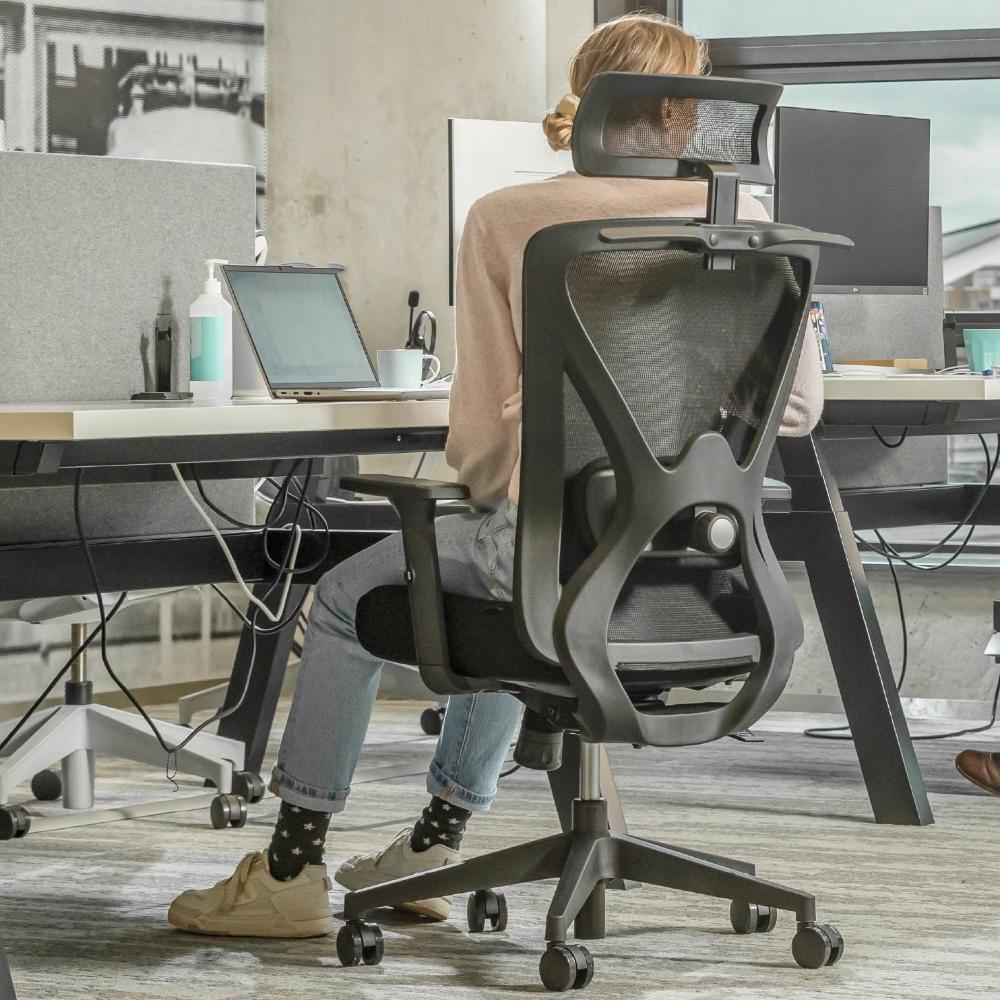Ergonomic sitting: comfort and health at your home workspace
Share
Ergonomic sitting: complete guide for home work comfort & productivity
At home at your home office desk or desk table? With the right settings and the right tools—such as an ergonomic sitting ball, an office chair (ergonomic) and an sit-stand desk—you make ergonomic sitting simple and effective.
Why ergonomic sitting is important
Ergonomic sitting is about alignment and support. A neutral spine, relaxed shoulders, and good pressure distribution prevent complaints in back, neck, and wrists—and increase your focus.
Do you work a lot desk working from home? Then every small improvement pays off. Start with a solid foundation and add dynamics to prevent stiffness.
Quick deepening: read Backerz’ articles best ergonomic office chair & sitting solutions, set up your workspace ergonomically in 10 minutes and sitting balls: trend or smart choice?.
How to set up your workspace (3 minutes)
- Seat height: feet flat, knees around 90°. Adjust your chair with the lever (↑/↓). For fine adjustment, choose for example the Motion Mesh.
- Seat depth & lumbar support: leave a fist's width behind your knees; position the lumbar support in the curve of your lower back.
- Armrests: elbows ~90°, shoulders relaxed. Arms close to your body.
- Screen & keyboard: top edge of the screen at eye level; viewing distance ~ arm's length; keyboard straight in front of you, wrists neutral.
- Desk height: if you work at a fixed desk, set the chair properly for you and add a footrest if necessary. With an electric sit-stand desk you can switch effortlessly.
Pro tip: want to quickly switch from sitting to standing? The Backerz sit-stand desk (set) offers a ready-made upgrade for your home workspace.
Smart solutions: chair, sitting ball, stool & sit-stand
1) Office chair (ergonomic)
An ergonomic office chair with adjustable seat height, seat depth, backrest, and armrests is the foundation. The Motion Mesh breathes well and provides reliable support during long days.
2) Ergonomic sitting ball
Alternating with an ergonomic sitting ball activates your core and promotes micro-movement. Use the ball in blocks of 20–40 minutes for dynamics without compromising stability.
3) Wobble chair / wobble stool
Looking for dynamics with a bit more support than a ball? The wobble stool allows subtle tilting and turning, keeping you actively sitting upright. Handy for creative tasks or calls.
4) Sit-stand desk
Regularly change posture with an electric sit-stand desk. Program height profiles and start with 2–3 standing blocks per day. Prefer complete right away? Consider the sit-stand set.
5) Specific support: work stool
For tasks close to the work surface, an ergonomic work stool is ideal: compact, maneuverable and with an active sitting posture that protects your back.
Variation & micro-breaks
- 25-5 rule: work focused for 25 minutes, move for 5 minutes (stairs up/down, get water, short stretch).
- Alternate sitting forms: rotate between chair, sitting ball and wobble stool.
- Standing blocks: plan 2–3 standing moments of 20–30 minutes with your sit-stand desk.
- Mini-reset: shrug-roll shoulders, tuck chin, wrist and forearm stretch. Repeat every hour.
Read more: ergonomic workspace in 10 minutes • sitting balls: trend or smart choice?
Common mistakes (and quick fixes)
- Screen too low/high: top edge at eye level, viewing distance ~ arm's length.
- Ignoring armrests: adjust them so shoulders hang loosely.
- Sitting too deep: keep a fist width free behind the knees.
- No variation: plan standing blocks with your sit-stand desk and alternate with sitting ball or wobble stool.
- Only focus on price: “cheap office chairs” are fine if they are adjustable and provide lumbar support; test features and fit.
Unsure which combination suits you? Also check our guide for back complaints.
Frequently asked questions
How quickly do I notice results from ergonomic sitting?
Often immediately less tension in shoulders and lower back; after 1–2 weeks of getting used to the new settings your endurance improves.
Is a wobble chair the same as a wobble stool?
Commonly yes; Backerz’ wobble stool offers controlled dynamics without compromising stability.
How often should I work standing?
Start with 2–3 standing blocks of 20–30 min per day and build up. Use memory settings of your sit-stand desk.
Can I use a sitting ball all day?
Better not: use the sitting ball as dynamic variation alongside your office chair for the best balance.
Get started: your ergonomic upgrade
Ready to improve your workplace? Choose your next step:
- Ergonomic office chair for immediate comfort gain.
- Ergonomic sitting ball for dynamic variation.
- Wobble stool for active, stable micro-movement.
- Sit-stand desk (electric) or the complete set for quick results.
- Ergonomic work stool for focus tasks close to the work surface.

